HERE.
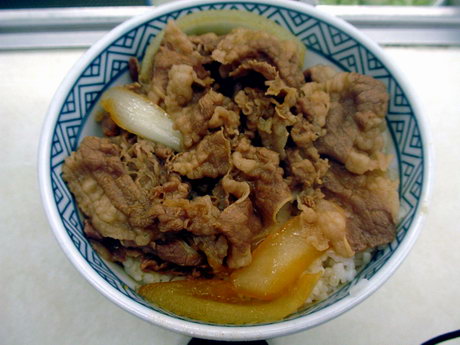
Just in time for my last-minute feeding on all things quintessentially nihon.
Here’s to the next million, and the next, and the next…
I’ve been waiting, patiently, for three years – it’s not just the don itself that I desire, it’s the ability to stroll into the little shop with the orange sign and cramped seating 24/7 and know that my little mound (read: ? and only ?) of heavenly stewed beef topped with a raw egg is instantly and inexpensively available for me, and only me, me, me. Okay, that last part is flexible, I’ll share with you, because you’re speeeecial. Let’s gyu.
UPDATE: On the other side of the spectrum lies shit beneath one’s contempt. Like a “Trout Burger“. That’s the most ironic fish-related term since “delicious bass.”
Just for the record, this article hit me hard because I am Rainbow Trout Nazi. I hereby proclaim the One True Way regarding preparation of rainbow trout: Lightly breaded and pan fried, drizzled with fresh lemon juice – this is because rainbow trout meat is inherently mushy. Wrapped in basil and watercress? Crispy miso? That sounds like a euphemism for shit-stained BVDs. Hey yo, fuck a trout burger. Seriously.
Category: Japanese Society/Culture
Passing the Torch
My time is almost up; the next wave of invaders is already here. I have seen them on the streets and I hear them on the trains. I leave the future colonization of Japan in their able hands.
A Prison Camp Memoir
Excerpts from another great memoir over on the JPRI site:
“The radio went dead. All the servants had long disappeared–stealing everything they could carry.
I locked all the doors and shutters and stayed in the dark. The planes were flying very low now, using the tramcar lines along the boulevard as a guide. When they opened up with their machine-guns, I guessed that the troops were near.
It was a long, long night. When dawn arrived, I couldn’t understand the sudden quiet, and ventured to the gate to look up to the main street. Imagine my astonishment when I saw thousands of troops marching softly past, carrying or riding bicycles! I learned later that 75,000 men entered Soerabaya that day.
I stayed locked in the house waiting for them to come for me, as I knew they would. It was dark before the hammering started on the door. I was terrified, but knew I had to hide it. So, carrying Jackie in my arms I opened the door. There were six storm troopers with fixed bayonets at the entrance. They pushed past me yelling for everybody to come out. They looked very tired, unshaven, hot and dirty and very violent.”
………….
“On a diet of rice and vegetable soup (a cup of each) three times a day, the casualties soon started to appear. The fat women seemed to show it first as they lost weight so quickly. The thin ones like myself lost weight, but it didn’t show so badly. Luckily I liked rice so had no trouble swallowing it. There were no eggs, meat, fruit or milk. We were allowed a spoon of sugar each per day.
The Japanese insisted that everything delivered as food went into the pot. There were no peelings, and even the greens of carrots were thrown in–but still there was not enough to go around. Many of the growing children were very hungry.
If it had not been so frightening it would have been interesting to see how quickly signs of malnutrition started to show–stomachs and ankles started to swell. Another inexplicable thing to me was that from the moment I was interned, until I was released I never menstruated once. Also although I ate exactly the same food, my ankles never swelled.
Soon dysentery swept through the camp and in the heat the smell was terrible, and of course people began to die. I was so grateful I had brought along Jackie’s pot, for we both used it throughout internment and didn’t catch dysentery.
I know how badly the men were treated in their camps, but I think the plight of the women has perhaps not been truly understood. They had their children to care for, and had to watch them go hungry. They were suddenly deprived of their wealth and position in society–and the aggravation amongst themselves was tragic to watch. Of course all classes were thrown together–we were only numbers now.”
………….
“Kimura ordered her out of the office and walked her to the middle of the compound, where everybody could see. It was dark, and I could only see shadows in the background. My legs felt weak and my stomach sick. He started to beat her up, and when I say “beat,” I really mean it. He slapped her about the face with his open hand until it started to look like raw beefsteak. All the time he was giving me a running commentary of what he was doing. Although swollen and raw no blood flowed from her face. He then hit her ears, carefully demonstrating to me how he cupped his hands to avoid breaking her eardrum. She was reeling from side to side until she fell unconscious to the ground.
He turned away as a cat from a dead mouse. She didn’t amuse him any more.
I called out for help after he had gone and a few women came out and helped me get her to the hospital. We were in luck for once. Earlier in the day I had interpreted for the doctor, who thought she had a diphtheria victim and needed ice. Surprisingly, we got some brought in and we now packed this over the woman’s swollen face. Just as Kimura had said, you couldn’t see a mark on her next day!”
………….
What an amazing story. This woman went through some crazy hardships and survived; go read the whole paper.
Japanese “Lawsuit” Guitars

They are known as lawsuit guitars because they are of such good quality (often matching or even surpassing the original Fenders and Gibsons they replicate), that:
Around 1981, though, Fender, Gibson, Rickenbacker and a few other US guitar manufacturers got their hands on some “lawsuit” guitars made in Japan and quickly threatened to sue when they saw how exact the Japanese replicas really were. The Japanese replica-making guitar manufacturers were forced to stop making these “copy” guitars around 1983.
There are still tons of these guitars around if you search the used guitar shops and pawn shops, although some of the more famous models outprice the American equivalents they were originally based on!
Read more about the lawsuit guitars on this site.
Hardcore
Did someone forgot to take their meds?
In the essay titled “Killing Kittens” in the newspaper’s Aug. 18 evening edition, Bando, 48, wrote that she owns three pet cats and throws their kittens off the cliff near her house on the South Pacific island of Tahiti whenever they give birth to any.
“I am fully aware what severe criticism I may face if I write this,” she says at the outset of the essay. “I will probably be condemned as a savage by animal lovers around the world, and people may say I am violating the animal protection law. Knowing this, I confess I am killing kittens.”
Bando writes that although she had considered having her cats sterilized she has not done so, because she thinks that having sex when they are on heat and giving birth to offspring is what “life” is all about for a female cat.
“I have doubts about simply depriving them of their essential life for simply for the convenience of humans,” she says.
(link to full article)
She has doubts about depriving her cats of “life” for her own convenience, but has no qualms about doing the same to kittens? It takes a special kind of crazy to see the logic here, I’m guessing.
So the real question is: Is this just a stunt to revitalize book sales, or is this banzai cliff bitch really that crazy? I vote for the former, because the statement “knowing this, I confess I am killing kittens” is just too perfect – it’s designed to provoke a response. Like a book burning.
Ryukyu Underground
I came across this fascinating article over at the website of the Japan Policy Research Institute: A Wild Start: Okinawa in the 1970s
Excerpts:
“Gate Two Street and BC Street in Koza City was where the best wide-open bar district action was, except for the majority of Afro-American servicemen. Some of those guys did party with us Euro-American and Latino-American servicemen and go bar hopping with us, but most GI Soul Brothers stuck to “The Bush.”
The Bush was an all black environment. The Soul Brothers had nearly completely segregated themselves out of all the other bar districts on The Rock a long time before I got there.
Oh, that probably isn’t correct. I bet that they had been segregated out of the light-skinned GI’s bar districts way back in the beginning of American troop occupation of the island. Then the black guys had liked what they were left with, because they had made themselves a place of their own that fit their lifestyles and cultural tastes, so they kept it.”
and:
“Only Okinawans worked in the civilian bars on The Rock. In a Gate Two/BC Street type of A-Sign bar, there were bartenders, bar bouncers and doormen who were all good at fighting Karate style. When a fight started in an A-Sign bar, between a GI, or GIs, and one of the Okinawans working there, if the GI, or GIs, didn’t give up, back off and get the hell out of there real quick, or get knocked unconscious right away, the unfortunate GIs got the crap Karate kicked out of them by some, or all, of the Okinawan men working in that bar. If any of the fighting occurred outside a bar, then the bouncers and doormen from the other bars in the immediate area came over and jumped into the action and backed up their brethren Okinawans; that way any other GIs in the immediate area would be discouraged from jumping in on the side of the unfortunate GIs. If any GI got knocked on the ground by the bouncers, then the Okinawans all took turns kicking the poor guy.”
and:
“When the bar, brothel, massage parlor girls were eighteen years old, after studying hard during twelve years of going to school, six days a week, for eleven months a year, life as they had known it was over. If any girl ran away from the mamasan/papasan, who held her in bonded servitude, the Okinawan cops went and fetched her back. It’s a small island, after all: where was she going to hide for long?”
Go read the whole thing.
………………
Actually the thing that drew me into the article to begin with was the mention of the Asapen Spotmatic camera. I borrowed one off of Nam’s dad for a while (he left it at her place when he came to visit her at Tenri U) when I first started working in Osaka and wasted many rolls of film with it, but I still love that camera. Old guys would stop me on the street all the time with comments like, natsukashi, na! (“that sure brings back memories!”) And when I took it to a camera shop for repair, the guy did it for free and complimented me for being so old school! I kinda felt like shit because I barely knew how to use it at the time, but his praise sure sure put a smile on my face…
Sex Trafficking in Japan
An interesting article on the current state of affairs: The trafficking scourge
“Yet to paint a picture of the victims of trafficking as poor, uneducated women duped into prostitution and kept under close guard would not be completely accurate. “Most cases are not that simple,” says Ms. Fujiwara of the Polaris Project.
She tells a story of one woman from an East Asian country who had a degree from a vocational school and was making a decent living in the social welfare field, but wanted to change careers and save enough money to study in Japan. She read an advertisement for a position in a café in Tokyo that would provide her with transportation and a free place to stay. The mamasan in charge of the bar even flew from Japan to meet her and interview her in person. Although her friends said it sounded sketchy, she decided to take the job and flew to Japan.
However, she soon realized that the café where she would work was really a hostess bar. Soon after she started working, the mamasan closed the bar, citing financial troubles. She provided her with a high-interest loan, and referred her to another hostess club. But her new club required dohan, which is “dating” clients, and usually included sex. Other women working at the bar advised her to do it, as it would be “dangerous” for her to refuse.
Two years later, unable to pay off her debt, she contacted Ms. Fujiwara. She was identified as a trafficking victim, and the authorities were contacted. However, soon after, she ceased contact with Ms. Fujiwara, and her whereabouts are currently unknown. The club she worked at is still in business.”
I’ve heard a million stories like this. Fucking sad. I would say that the victims are usually aware that they are in for something like this, and choose to go anyway, which makes it no less sad.
Tobita (Google Images link), the largest red light district in Osaka, is truly a side of Japan you need to see to believe. It is one of only two areas in Osaka that I’ve been to where drug dealers are brazen enough to deal in the open. The article describes open air rooms, but when I went the girls were actually displayed behind large windows ala Amsterdam. The cops patrol the area on bicycles or on foot, but the only law enforcement I saw them doing was ticketing cars on the street (but ignoring the obviously yak ones – the local saying is that there are “as many yakuza as there are girls” in Tobita).
*note: I went to Tobita with a friend, three times over the space of 12 years to see what it was about. I would recommend it to anyone who wants to see a Japanese crack whore in a kimono, or for that matter what a Japanese cop getting paid off looks like.
Biwako Hot Dog (??????????)
This is a foodblogging post I have put off for a year and a half. The photos were waiting patiently to be edited on my desktop for all that time, and I continually ignored their pleas of “Post me! Post me!” So it is finally time for the story to be told:
A short time before encountering the Biwako Hot Dog, I wrote a post detailing the history of the Japanese fish sausage (which has turned into sort of a resource center for aspiring fish sausage makers worldwide – go read the comments!). So it was a happy coincidence that found us cruising the mountains around Lake Biwa, because the snowboarding trip we planned had been rained out. It was an absolutely miserable day, weather-wise. And the photos of death and decay on that link convey the mood we were in quite well.
The day was saved, however, by the appearance of a black and yellow kei (ultra compact 660cc class) van on the side of the road:
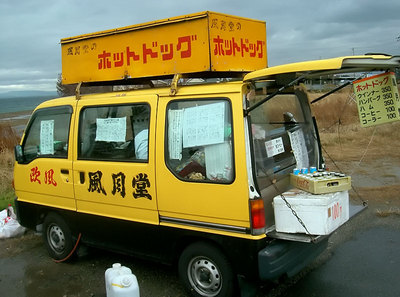
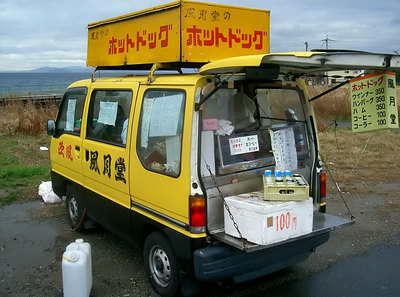
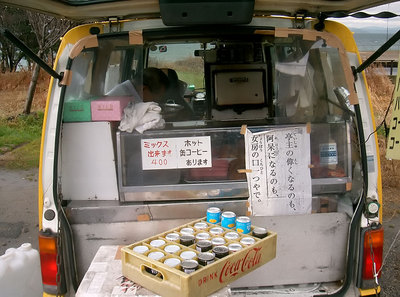
(click any of the images above to open a larger version)
The menu hanging off the back door of the van says:
Hot Dogs
w/wiener: 350 (yen)
w/hamburger patty: 350
w/ham: 350
Coffee: 100
Cola: 100
The photocopied papers stuck to the side windows were pretty crazy, stuff about how women are the bane of mankind and how God hates them (but men must respect them) and whatnot… The message was basically that the owner had had a hard life and gone completely batshit – we were intrigued.
The owner, an old fellow, was snoring when we walked up – classic! – and had apparently fallen asleep in the middle of preparations. He woke suddenly as we called to him and carried on with his actions exactly where he had left off, as if nothing had happened. We felt bad for waking him, and ordered three of each kind of dog. He was cool and gave us a couple extra – not many customers that day because of the crappy weather, I think.
The traditional Japanese hot dog is a hot dog purist’s worst nightmare. Even discounting the type with a hamburger patty or a slice of ham, the wiener type is sacrilege mainly because it employs fish sausage (examples here and here). Because of the use of this quite-inferior sausage, the entire experience is ruined for approximately 100% (+/-.001%) of westerners. (This is especially ironic because of the word ?? (“European style”) written on the passenger door of the van.) However, many Japanese profess to love this taste because it brings back memories of school lunches… Hey, to each his own – I sometimes yearn for the days of sloppy joes and tater tots, too.
Behold the traditional Japanese hot dog in its full glory:
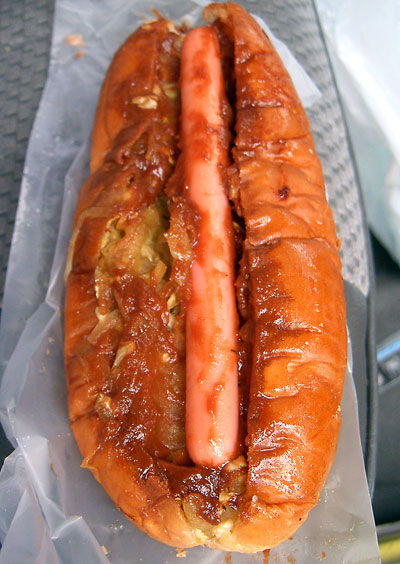
What sets the real thing apart from all fish-dog wannabes is the curried cabbage shreds (prepared in the RINNAI oven seen in the photo third from the top), as well as the karashi (hot mustard) infused sauce slathered all over the top. Since the fish sausage has so little flavor (and actually the hamburger patty and “ham” were ALSO fish-based processed meat), the main flavor comes from the karashi, the cabbage, and the white bread bun. In a word: blah. However, if you ever have a chance to try this food item, it will give you a chance to taste the cafeteria youth of your Japanese friends, and in this regard, it has true cultural value (and at least it tastes better than okara, another contender for this honor)
Marriage in Japan, redux
Found this interesting (and, as far as I can tell, accurate) node over at everything: How to marry a Japanese person
The author’s conclusion is that “international marriages do not work under Japanese law.” I think this a bit extreme, but some of the points outlined certainly defy all logic. Interesting reading, anyway.
